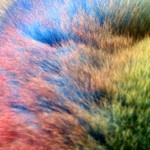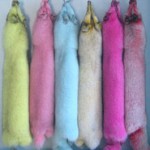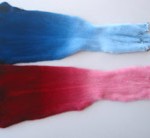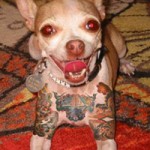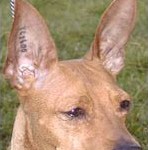A character’s natural appearance can be modified and altered in many ways. Some Luperci may practice body modification for spiritual reasons, as rites of passage, or simply for aesthetic reasons.
Not all characters will have the skill and knowledge to pierce, brand, tattoo, or even dye themselves however. If you are interested in having your character learn how to do these things, remember to be realistic in their learning — a beginner would have difficulty piercing advanced areas (tongue, navel, etc.) or inking certain tattoos. Even dyes may not yield the expected color the first time around!
Fur Dyeing
A non-permanent means of modifying appearance is the dyeing of fur. Results from natural dyes may be very light and non-vivid; however, repeated dyeing may yield brighter color. Dyeing only works from light to color, or where the dyed color is darker than the fur. Furs that are naturally dark will only hold a faint tint. Bleaching dark fur is possible, but human-made bleaches have weakened over time, and natural-made bleaches are not as potent to begin with.
It is not possible for Luperci to permanently dye their fur. The color itself fades, and additionally — fur is shed and lost at least twice a year.
Process
- Dyes can be created using natural material like bark, leaves, berries and nuts. Pigments are generally strongest when using fresh plant material.
- Dyes can be applied in a bath (e.g., by placing the dye in a container and dunking the body part into the dye), by splashing over the body, or even by “painting” on. No dyeing method is precise — sharp, clear lines cannot be achieved with dyeing processes.
- It is worth noting that some areas require assistance. For example — your character is not physically able to extend their arms around their back to reach between their shoulder blades to dye. It is also easier to achieve consistent results and colors with another pair of hands in general. Keep this in mind when exploring dyeing.
Piercing
Piercing is a very old form of body modification; most piercings possible in humans are possible in Luperci.
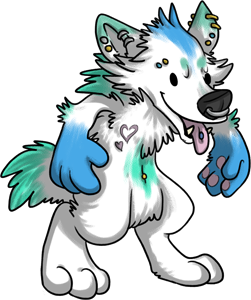 Possible Areas
Possible Areas
- Ears: The ears are a common piercing site; most piercers will be experienced with ear piercings. The lobe near to the skull or the upper ear are common places.
- Nose: Nose piercings, either to the side of the nose or through the center, are possible in canines.
- Lip: Variations of this include things similar to monroe piercings and medusa piercings.
- Tongue: Tongue piercings are more risky in canines, as they lack the dexterity of the mouth in humans and have a much more powerful bite.
- Other: Other piercings, such as nipple, navel, and genital piercings are less common, and carry many of the same risks as they do in humans. It is rare to encounter a canine with these types of piercings, and harder to find a canine capable of piercing in these areas.
Tools
Piercing requires a needle (these can be metal and man-made leftovers, or made of sharpened bone, etc.). If there is flesh behind the piercing area (e.g., the lobe of the ear where the needle, if poked too far through the ear, may pierce the neck or skull) a piece of wood, cork, or other semi-soft material — hard material may break the needle — may be used to shield the flesh.
Jewelry
Piercing jewelry differs depending on the area of the body (e.g., an eyebrow ring is very different in appearance and shape from an earring). Jewelry can be repurposed to some extent; however, the most comfort is generally achieved by using jewelry for its intended body part.
Jewelry can be simple or intricate, but your character will still need to hunt and move! Intricate jewelry — e.g., dangling jewelry that makes noise or is likely to snag on a branch while hunting — is not recommended.
Bone, wood, horn, stone, amber, minerals, and other materials have been used to make jewelry as well as adorn it, but metal is safest and least likely to cause infection. Gold and sterling silver are ill-advised as jewelry in fresh and healing piercings; stainless steel, scavenged from humanity, and less-reactive metals are preferred.
Risks
- Excessive piercing or very heavy piercings will result in reduced, delayed movement of the ears, lips, tongue, etc.
- Piercings can be misaligned — it may be very difficult to remove or put in jewelry with misaligned piercings.
- Infection is an extremely common risk in piercings during the healing process. Proper care can mitigate this risk to some degree, but it is inherent in all piercings and may occur despite a Luperci’s best efforts at care.
- Injury to the pierced area can be very traumatic. Dental trauma can occur with mouth piercings (both tongue and lip). Piercings are very disadvantageous in combat.
Process
- Jewelry and piercing tools should be sterilized prior to use. Strong alcohol or fire can be used.
- The piercer uses a needle of the appropriate type to pierce the flesh.
- The needle is removed and the jewelry is inserted into the piercing.
Healing
Healing a piercing can take between a few weeks for some, a few months for others, or even a few years for piercings in complicated spots. Salt water can be used to soak piercings; solutions are particularly effective. Playing with the piercing, touching, or rotating it can increase infection chances and may make it more difficult for the piercing to heal.
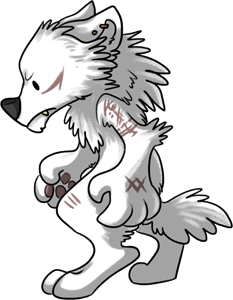 Scarification and Branding
Scarification and Branding
Scarification is a very old method of body modification, involving the use of sharp tools to carve a design into flesh. Branding is another old method — instead of cutting, branding uses heated tools to burn a design into flesh.
Branding and scarification are both often used as a base for tattoed areas — either to clear the fur from a given area permanently, or to trace a design in the fur. Both are advantageous because the fur will not grow back; the design is visible even on a heavily furred area.
Tools
Branding requires more tools than scarification — not only is a heat source such as fire required, but in order to achieve very intricate designs, the tool used to brand must be in the shape of that item. This usually requires knowledge of metalworking, as this will achieve the finest lines and greatest control over the design. More simple designs can be achieved by using simple blunted metal objects, but this offers far less precision.
Scarification can be performed with tooth and claw — however, intricate designs are best done with handheld tools (e.g., a sharp blade of obsidian or a scalpel leftover from humanity).
Risks
As with piercings, infection is a risk. Body modification artists who perform these processes should have detailed knowledge about the Luperci body in order to prevent tools cutting too deep, cutting the wrong area, burning too hot, or burning for too long. All of the above can cause major trauma — to the point of killing the canine receiving the scar or brand.
An additional risk of over-scarifying or over-branding is the decrease in survivability, if taken to extreme: canines can survive in cold areas because they have thick fur that covers much of their bodies. Permanently removing this protection with modification presents an obvious risk.
Process
Scarification
- The fur is shaved smooth down to the skin.
- The tool is drawn through the flesh to create a scar.
Branding
- The brand is heated. Knowing how hot to get the branding tool is crucial for the artist.
- Strike-branding requires that the artist holds the heated object against the skin long enough to cause burn damage. Quick taps will not cause enough scarring and damage to the skin.
- While the artist is applying the brand, the canine receiving the brand should not struggle or squirm — this will result in a blurry branding. All brandings are blurry to some extent, but remaining still can mitigate especially bad blurring.
Branding Healing
Scarifications and brands take a very long time to heal. Those intending to tattoo over a branded or scarred area should wait until the brand is very well healed before attempting to tattoo. Both can be left alone or irritated by ash or sand to ensure a deeper, more visible mark.
Tattooing
Tattooing requires a scar/brand base, a thin area of fur, or constant shaving to be visible on a Luperci.
Tattooing works by putting ink in the second layer of skin. Canine tattoos don’t work the same as they do with people. Canine fur is often thick with many layers; in most areas, a tattoo would simply be covered by fur growth. There are three ways to go about getting around this problem. You could have a tattoo in a place with very thin or no hair, shaving constantly, or by scarifying/branding and then tattooing.
Risks
Risks of tattooing are similar to other forms of body modification — infection presents the most immediate danger. Unlike other forms of body modification, however, there is less potential for permanent damage in the long run (tattoos aren’t like piercings in that they can’t be ripped off!).
Process
If a canine is not branded or scarred to yield a hairless canvas, hair must be shaved before a tattoo is applied. This is done not only to give the artist a clean working area, but also to allow the area to be disinfected prior to (and after) tattooing.
Tattoo guns run off electricity — an obvious no-no for canines in the ‘Soulsverse. A realistic tattooing technique available to Luperci is called tebori. The artist uses hand-made tools and repeatedly jabs their sharp needles under the skin. While a more painful and a much longer process, the results are just as vibrant as modern tattoos. The pigment is kept in small vessels during the tattooing process. The needle is repeatedly dipped in the ink; an artist must pause often to re-ink the needle.
For something large and intricate, upwards of 20 hours or more is an average time estimate. This process is often spread over periods of days or even weeks to allow for healing and rest.
Healing
As with other forms of permanent modification, infection is possible. Making sure that the tattoo stays clean and moist over several weeks not only helps prevent infection and promotes healing for a vibrant, sharply-lined tattoo. Beeswax is a natural agent that can be used in such a manner. Over time, exposure to the sun, salt-water, and other chemicals will pull the colors out from the tattoo, so it’s expected that on canines out in the wilderness there will be no perfect tattoos.
